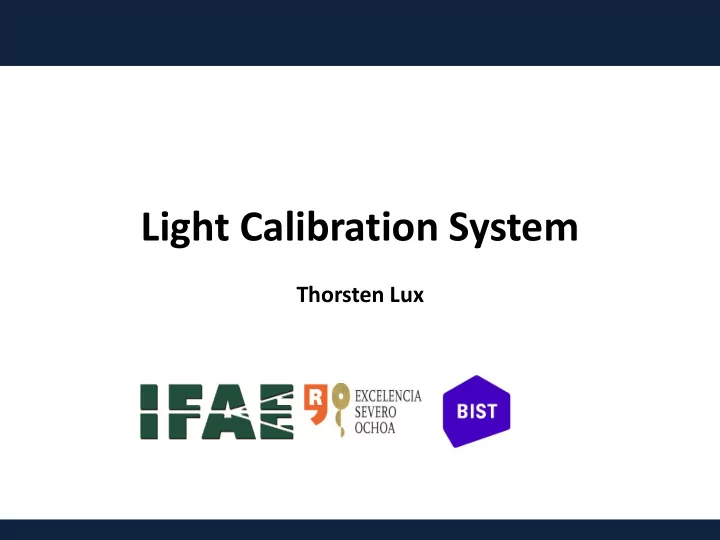

Light Calibration System Thorsten Lux
Overall Conceptual Design X2 Air Black Box Cryostat Inside: • 2 feedthroughs CF40, each Clara’s talk 2 weeks ago with 3 optical feedthroughs • 6 SMA optical fibers from feedthrough to black box • black box containing light source • black box on top of cryostat 12/06/2017 Thorsten Lux 2
Components • Commercial box from Thorlabs: 525 mm x 375 mm x 300 mm (L x W x H) • Kaputschinsky LED drivers as light source (https://arxiv.org/ftp/physics/papers/0410/0410281.pdf) • Provides fast pulses of few ns • Rate: 1 kHz (possible to increase to around 10 kHz) • 2 voltages needed: • DC between 0 and -20 V for intensity • pulsed to trigger light pulse • Default LED: NSPB300B (465 nm) (more later) • BeagleBoard (BeagleBoard.org) • Easy control via ethernet e.g. with Python • 8 outputs to provide pulses for Kaputschinsky and also TTL signal for trigger • 7 ADC channels e.g. to read temperature sensor 12/06/2017 Thorsten Lux 3
Components • SMA-SMA fiber from Thorlabs (1000 um diameter): M59L • SMA-SMA feedthrough from Thorlabs: ADASMA • Optical fiber on one side – LED directly on other side • Reference sensor still open point • Powermeter seem not to work (see later) • Either SiPM or PMT • In contact with Cayetano to check if spare readout channel is available to digitize reference sensor • Alternative: use ADC of BeagleBoard 12/06/2017 Thorsten Lux 4
Black Box • 6 Kaputschinsky LED driver • All 6 controlled by 1 Kaputschinsky PCB BeagleBoard 1 • LEDs can be switched on individually, in groups or all 2 Reference together Sensor • each LED coupled to an 3 individual SMA optical fiber 4 • 3 fibers going to one CF40 BeagleBoard flange 6 5 • One DC voltage for all 6 Kaputschinsky Optical fiber 12/06/2017 Thorsten Lux 5
LED Coupling to Optical Fiber Kaputschinsky Stray light used for with blue LED reference sensor PMT/SiPM Black box Optical fiber 12/06/2017 Thorsten Lux 6
Implementation (Conceptual) • central reference sensor • 6 Kaputschinsky PCBs around • each Kaputschinsky with light cavity to guide light to reference Kaputschinsky sensor PCB • material: either 3D printed plastic or aluminium Reference Sensor Position of LED Reference adjustable sensor Stray light LED Feedthrough Fiber 12/06/2017 Thorsten Lux 7
Proof-of-Principle Tests Powermeter (measuring light reaching feedthrough) LED reflector Reflective tube Optical PMT fiber 12/06/2017 Thorsten Lux 8
Comparison PMT and Powermeter • Signal from PMT compared with signal from powermeter • normalized to largest signal • similar shape (amplitude of PMT read by eye from oscilloscope => large error) => “stray light” detected by reference light will allow to estimate injected light to PMTs 1,2 1 0,8 Normalized Signal 0,6 Powermeter 0,4 Reference PMT 0,2 0 0 5 10 15 20 -0,2 LED Bias Voltage [V] 12/06/2017 Thorsten Lux 9
Testing various LEDs • Testing various LEDs: 465 nm, 525 nm, 3 of 430 nm • the 3 LEDs of 430 nm do not/ almost not work with Kaputschinsky • Trying to find other 430 nm LEDs • Green LED more power than blue LED • 15 nW (blue) correspond to 3.5E10 photons of 465 nm per pulse (1 kHz) reaching the feedthrough on top of the cryostat 45 40 35 30 Power [nW] 25 Blue LED (465 nm) 20 Green LED (525 nm) 15 10 5 0 0 5 10 15 20 25 -5 LED Bias Voltage 12/06/2017 Thorsten Lux 10
Time Structure of Light Pulse Old blue LED Old green LED • Green LED with longer tail than blue LED • New green LED with much longer tail than old green LED (same model) • No difference for blue LEDs • Pulse width: 15 ns for blue LED New blue LED New green LED 12/06/2017 Thorsten Lux 11
Summary • The light calibration system be based on 6 Kaputschinsky LED driver • Blue LED (465 nm) default choice currently • BeagleBoard will allow to control drivers (individually, groups, all together) • 1 reference sensor: SiPM or PMT • Either standard ADC to digitize signal or built-in ADC • Needed cables: – 3 BNC cables – 1 Ethernet cable – 1 trigger out cable – 2 spare cables • Simplified test of the principle performed successfully • Most of the commercial parts ordered • Production drawings in process for light cavity and LED driver PCB 12/06/2017 Thorsten Lux 12
Recommend
More recommend